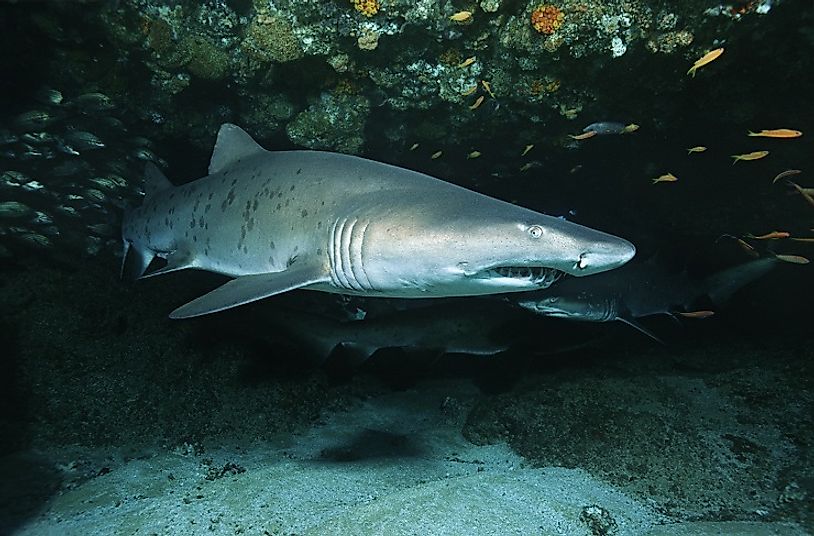Sand Tiger Sharks: Oceanic Cannibals

5. Physical Characteristics
With their ferocious appearance and reputation of practicing adelphophagy (the eating of one's siblings), anyone would fear the sand tiger sharks which are, however, actually quite non-aggressive in nature, known to attack humans only when threatened or disturbed. These sharks, growing up to about 2 to 3.2 meters in length and weighing up to 91 to 159 kilograms, have a brownish grey color on the top, with rust-colored spots while their ventral surface is largely whitish in color. The sharks have sharp teeth which are visible even when their mouths are shut. They have a conical snout which is flattened at the top. They also exhibit the unique behavior of surfacing above water to gulp air which is stored in their stomach, allowing them to float in the water while waiting for prey.
4. Habitat and Range
The sand tiger sharks occupy a wide variety of marine habitats including the mesopelagic and epipelagic zones of oceans near the shorelines, estuaries, reefs, and shallow bays. They are found at ocean depths of up to about 623 feet. They are found in most major oceans of the world including the Atlantic, Pacific and the Indian Oceans. They are also found in the Mediterranean Sea, Red Sea, and the Adriatic Sea. The sharks inhabiting the oceans around Australia and South Africa have exhibit an annual migration from south to north during winter, covering distances as long as 1,000 kilometers.
3. Diet and Adelphophagy
The sand tiger sharks rely on benthic marine species for their food. They hunt at the depths of the oceans where they feed on a variety of benthic bony fishes which forms about 60% of their diet. The sharks also feed on other shark species like the smooth-hound shark as well as rays and skates. While there is nothing unusual about the diet of adult sand tiger sharks, the diet of the baby sharks in the mother’s womb is often quite unimaginable. In this species, dozens of eggs of the female are fertilized by the multiple male partners of the female shark. However, not all embryos develop at the same rate and the healthier embryo after attaining a certain size starts devouring the other embryos within the uterus. It attacks, kills and feeds on these embryos, growing at an exponential rate during this feeding frenzy. Once it finishes off all its brothers and sisters, it turns to eating the eggs of its mother. The final result is that the newborn shark is so powerful that can easily defend itself against its predators in the wild.
2. Mating and Reproduction
March to April is the mating season of the sand tiger sharks in the Northern Hemisphere while in the Southern Hemisphere, the sharks mate between August and October. The female often mates with more than one male. The sharks’ courtship ritual lasts for several days when a dominant male drives away other males and fishes from the mating grounds and hovers around the female till she is ready to mate. The mating pair exhibits interest for each other by superficially biting each other. The actual episode of mating lasts only for a few minutes. After mating is over, the male wanders off in search of food while the female prepares to reproduce. She has two uterine horns, each of which produces only two embryos after the other embryos are destroyed by adelphophagy. After a gestation period of 8 to 12 months, fully independent young sharks are born. The female sand tiger sharks reproduce only once every two to three years.
1. A Vulnerable Species
The sand tiger sharks are extensively poached and their overfishing has led to a sharp decline in their population. The sharks are poached for their meat off the coast of India, Pakistan and Ghana, in Japan for their fins, in North America for their hide and fins, in South Africa as prized catches in fishing competitions as well as in many other parts of the world. They are also caught as bycatch in trawlers and fishing nets. Sand shark oil is used in preparing lipsticks. These animals are also captured live for exhibits in both public and personal aquariums. Recognizing the threats faced by this species, the International Union for the Conservation of Nature has classified the sand tiger shark as a "vulnerable" species. The sharks have been assigned a protected status in Australia and the United States and attempts are being made worldwide to reduce the poaching of this species.











